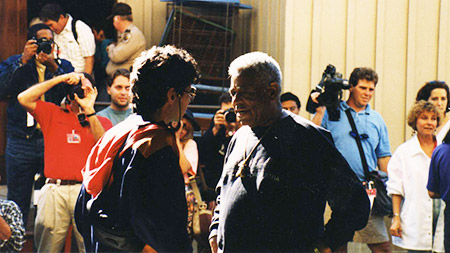
(Chick Corea & Dizzy Gillespie)
bflr.
Ah yes, moving right along.......................Why the breathless article then?
Why not get back to the population when the damn thing works and produces net energy? Don't the wonks behind this stuff think enough is enough with the announcements of new breakthroughs?
“In nuclear physics, nuclear fusion is a nuclear reaction in which two or more atomic nuclei come very close and then collide at a very high speed and join to form a new type of atomic nucleus. During this process, matter is not conserved because some of the matter of the fusing nuclei is converted to photons (energy). Fusion is the process that powers active or “main sequence” stars.
The fusion of two nuclei with lower masses than iron (which, along with nickel, has the largest binding energy per nucleon) generally releases energy, while the fusion of nuclei heavier than iron absorbs energy. The opposite is true for the reverse process, nuclear fission. This means that fusion generally occurs for lighter elements only, and likewise, that fission normally occurs only for heavier elements. There are extreme astrophysical events that can lead to short periods of fusion with heavier nuclei. This is the process that gives rise to nucleosynthesis, the creation of the heavy elements during events such as supernovae.
Following the discovery of quantum tunneling by Friedrich Hund, in 1929 Robert Atkinson and Fritz Houtermans used the measured masses of light elements to predict that large amounts of energy could be released by fusing small nuclei. Building upon the nuclear transmutation experiments by Ernest Rutherford, carried out several years earlier, the laboratory fusion of hydrogen isotopes was first accomplished by Mark Oliphant in 1932. During the remainder of that decade the steps of the main cycle of nuclear fusion in stars were worked out by Hans Bethe. Research into fusion for military purposes began in the early 1940s as part of the Manhattan Project. Fusion was accomplished in 1951 with the Greenhouse Item nuclear test. Nuclear fusion on a large scale in an explosion was first carried out on November 1, 1952, in the Ivy Mike hydrogen bomb test.
Research into developing controlled thermonuclear fusion for civil purposes also began in earnest in the 1950s, and it continues to this day. The present article is about the theory of fusion. For details of the quest for controlled fusion and its history, see the article Fusion power.”
http://en.wikipedia.org/wiki/Nuclear_fusion
The Energy Source of Tomorrow: Benefits of Nuclear Fusion Power - Ivan Pogrebnyak
Abstract:
In the search for sources of energy, discussions of nuclear fusion power as an option have often been seen as unrealistic, overshadowed by the viability of nuclear fission. Fusion power, however, would be an ideal answer to our current demand for economical and environmentally friendly energy production. This article discusses the mechanics of nuclear fusion and explains that, in terms of safety, resource availability, cost, and waste management, fusion power may be the best commercial option in the near future.
See more at:
http://pitjournal.unc.edu/article/energy-source-tomorrow-benefits-nuclear-fusion-power#sthash.jgIzmGsS.dpuf
We could have thousands of thorium reactors pumping out electricity merrily by then at a much smaller cost per watt.

(Chick Corea & Dizzy Gillespie)
